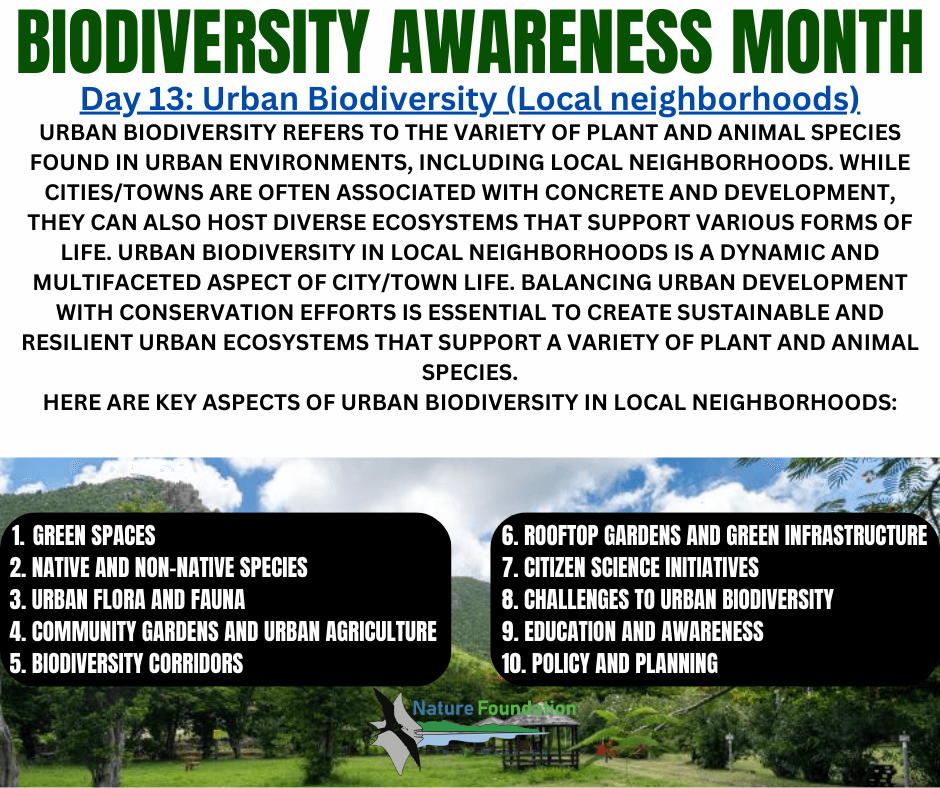Biodiversity month day 13: Urban biodiversity
Urban biodiversity refers to the variety of plant and animal species found in urban environments, including local neighborhoods within cities.
The St. Maarten Hospitality & Trade Association supports the March Biodiversity awareness month organized by the Nature Foundation in an effort to help protect St. Maartens nature and biodiversity. Todays topic: Urban Biodiversity
While cities are often associated with concrete and development, they can also host diverse ecosystems that support various forms of life. Here are key aspects of urban biodiversity in local neighborhoods:
1. Green Spaces: Urban green spaces such as parks, gardens, and tree-lined streets play a crucial role in supporting biodiversity. These areas provide habitats for a variety of plants, insects, birds, and small animals. Maintaining and expanding green spaces contributes to the overall health of urban ecosystems.
2. Native and Non-Native Species: Urban environments often host a mix of native and non-native plant and animal species. While non-native species can sometimes become invasive and disrupt local ecosystems, they may also contribute to urban biodiversity and provide additional habitats for wildlife.
3. Urban Flora and Fauna: Cities support a surprising diversity of flora and fauna. Trees, shrubs, and flowering plants attract pollinators such as bees and butterflies. Birds, small mammals, and insects find refuge and food in green areas and even in pockets of natural vegetation within urban neighborhoods.
4. Community Gardens and Urban Agriculture: Community gardens and urban agriculture initiatives contribute to urban biodiversity by introducing a variety of plant species and creating habitats for insects and birds. These spaces also promote community engagement and environmental education.
5. Biodiversity Corridors: Urban planners may design biodiversity corridors to connect green spaces and provide pathways for wildlife movement. These corridors help counteract the fragmentation of habitats caused by urban development.
6. Rooftop Gardens and Green Infrastructure: Rooftop gardens and green infrastructure, such as green roofs and walls, are becoming more common in urban areas. These features not only enhance the aesthetic appeal of buildings but also contribute to biodiversity by creating habitats and promoting urban cooling.
7. Citizen Science Initiatives: Residents of urban neighborhoods can participate in citizen science initiatives to monitor and document local biodiversity. This involvement can help raise awareness, contribute to scientific research, and inform conservation efforts.
8. Challenges to Urban Biodiversity: Urbanization, pollution, habitat fragmentation, and climate change pose challenges to urban biodiversity. Managing these challenges requires sustainable urban planning, pollution control measures, and the protection of green spaces.
9. Education and Awareness: Increasing awareness among urban residents about the importance of biodiversity and the role they can play in its conservation is crucial. Educational programs and initiatives can foster a sense of environmental responsibility.
10. Policy and Planning: Cities can implement policies and urban planning strategies that prioritize biodiversity conservation. This includes zoning regulations, green infrastructure requirements, and the incorporation of biodiversity considerations in urban development plans.
In conclusion, urban biodiversity in local neighborhoods is a dynamic and multifaceted aspect of city life. Balancing urban development with conservation efforts is essential to create sustainable and resilient urban ecosystems that support a variety of plant and animal species.
Back to the Visit St Maarten Main page

